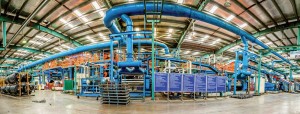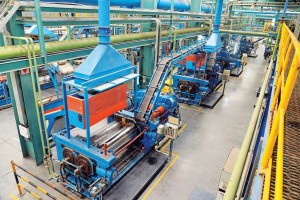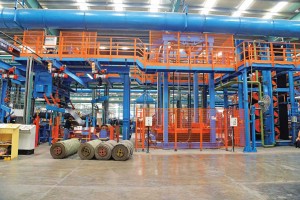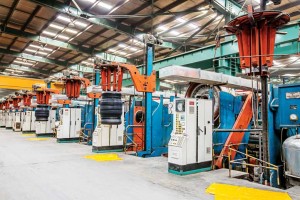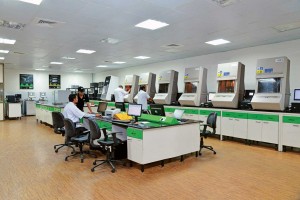BKT is eyeing a leadership role in the global OHT tyre market by means of a USD 500 million investment.
Story by: Bhushan Mhapralkar
Established in 1954 as a manufacturer of bicycle tyres at Aurangabad, Maharashtra, Mumbai-based BKT Tyres is changing the rules of the game. It is diligently working towards realising the vision of achieving leadership in the off-highway tyre market worldwide. The total size of the Off-Highway Tyre (OHT) is estimated to be around USD 15 billion. With over 90 per cent of its tyres exported to 130 countries, BKT is also working to increase its share of the domestic market. Claimed to derive 88 per cent of its revenue from exports, the company operates five facilities (Aurangabad, Dombivali, Bhiwadi, Chopanki and Bhuj) in India with an output of 600 Metric Tonnes (MT) per day. Slated to reach 800 MT per day by 2017, BKT commands a 4 per cent share of the global Off-Highway Tyre (OHT) market. Hoping to achieve its vision largely on the strength of its newest and youngest plant at Bhuj, which is in close proximity to the ports of Kandla and Mundra, the company, offering a product portfolio of over 2,400 SKUs, employees 7000 people. Producing over 230 sizes of agricultural radial tyres apart from solid tyres, port application tyres, crane tyres, earthmoving and construction equipment tyres, tipper tyres, and dump truck tyres, BKT supplies over 15 to 20 per cent of the tyres it produces to OEMs according to Rajiv Podar, the company’s joint managing director. A large chunk of BKT’s tyres are consumed by the replacement market.
Humongous is the word
Humongous is the word best suited to describe BKT’s Bhuj plant. Providing a distinct logistical advantage since 90 per cent of the products of the company are exported, the plant, spanning 312 acres of a parcel of land is home to the newest and the BKT’s biggest 49-inch dia. dump truck tyre. The tyre is said to cost a whopping Rs.15 to Rs.20 lakh. The main plant, with an achievable capacity to produce 350 Metric Tonnes (MT) of tyres, occupies 77 acres. The current capacity of the plant is 220 MT. It presently does 175 MT. Entering the international OHT market (radial agriculture tyre, which today represents the company’s main product segment at 75 per cent share) in 1994 through UK after identifying a mid-segment opportunity, the need for a new (Bhuj) plant was felt as the existing plants neared their full capacity. The going was good, the introduction of Agrimax tyre for high powered tractors in 2007, followed by an entry into the OTR all-steel radial tyres in 2008, having helped the company to secure a strong foothold in the international markets – mainly Europe and USA.
To achieve the vision of global leadership in OHT tyres, the need for a radical shift in manufacturing was found necessary. The need was for about 140,000 MT. All the departments were consulted, and a figure of 300 acres was arrived at. This was born out of the need to have a large warehouse to better channelise export consignments; to have a modern R&D to produce world-class products, and to have a large manufacturing foot print with the most modern machines. Post the permission of the board to invest USD 500 million, which according to Arvind Podar, the chairman and managing director, was the net worth of the company then, a continuous parcel of desolate, desert land was acquired with the help of Gujarat Government. Work started in 2011. The black soil was found to be unsuitable; excavation of up to 7 m had to be carried out. Bhuj’s seismic risk necessitated a structure that could withstand a tremor of up to nine on the Richter scale. “Lack of electricity, water and labour made it difficult. Eight-km long water lines were laid, and electricity lines over 30 km were laid out. The roof was engineered to withstand strong desert winds,” mentions Rajiv. To ensure self sufficiency, a 20 MW thermal power plant was invested into; two water reservoirs were invested into; a township over 15 acres of land was invested into, and includes a mall. A fire station and a hospital were also invested into. They are a part of the company’s CSR activity.
Well defined
Commissioned in 2012, the plant at Bhuj is set to add new products to the company’s already wide range of OHT tyres according to Dilip Vaidya, president and director of technology at BKT Tyres. With focus on increasing the domestic market share, and addressing the needs of farmers to whom BKT sells OHT tyres by offering them two-wheeler tyres for their motorcycles and scooters, it is the large warehouse that draws attention upon entering the plant. This is however not before catching a view of the R&D centre with two attractive tractors doing the testing rounds. Their are six test tracks that offer wet and dry driving conditions; the asphalt track measures seven-metre in width, and the concrete track measures five-metre in width according to Vaidya. There is also a circular dirt and stone track. Apart from prototype and handling tests, the track will enable BKT to carry out most common and specific tests including noise tests.
Inside, the warehouse, raw material like natural rubber, synthetic rubber, polybutyl and chlorobutyl rubber, bromobutyl rubber, sillica, carbon black, additives, accelerators, and more, procured locally and from international markets (like Thailand, Malaysia, Turkey, Poland and Vietnam), are systemically stacked and labeled. It is fed into the mixers as per the need to make a compound. The mixing area amounts to 16.8 acres and contains 440- and 330-litre mixers. According to Vaidya, the 440- litre mixers are for the master batch, and the 330-litre mixers are for the final batch. Over 228 compounds are made for different types of tyres. Supporting this operation is a dosing plant. The compounds, as they come out of the extruder past the mixer, are used to build bias ply, radial ply and solid tyres.
Employing young engineers trained at the Bhiwadi and Chopanki plants, the wide variety of tyres produced at Bhuj, and their uniqueness calls for unique monitoring. Presenting an opportunity to pursue the dreams according to Rajiv, the Bhuj plant is subject to strict monitoring of each an every process. “While the R&D centre will be operational next year, supporting the plant operations is an analytical lab, chemical and synthetic lab, compounding and sample preparation lab, physical lab, aging and life prediction lab, and a microscope lab to ensure top quality,” avers Vaidya. With hard compound calling for higher viscosity, softer compound calling for low viscosity, steel radial construction calling for higher viscosity, each compound batch is tested. Special software for Silica-based compounds with controlled temperature has been provided according to Vaidya. Kaizen is practised at the Bhuj plant.
Seven types of chords are used in the manufacture of tyres at Bhuj. For the manufacture of radial tyres, body ply cutter machines are employed. Over 95 per cent of the machines at the Bhuj plant are imported. They are instrumental is ensuring very good zipper quality. Says Vaidya, that the plant has 150 curing machines. There are four calendar rolling machines for textile and steel chords. These, adds Vaidya, provide better width control, fabric centering, tension control and uniform chord distribution. There’s a fully auto gauge control system and metal detectors to avoid roll damage. The duplex extruder includes a eight-inch hot feed and a six-inch cold feed line. Treads with two different layers can be made for high speed tyres with deep tread. There’s an auto bias cutter and a auto splicing system for perfect ply joint with uniform overlap. The splicers are especially made for agricultural OTR tyres. For most agricultural, industrial and flotation tyres up to 28-inch dia, BKT has installed building machines with turn-up bladder for wrinkle-less turn of operation. For 25-inch OTR and industrial tyres, there are turn-up bladders with 3D construction. For lamination, the company has developed spin station for the application of base and cap with two different compounds for superior quality.
Employing synchronous rotors and turn screw sheeters, the company, for giant OTR tyres, has installed a three stage tyre building machine. There are also these giant curing presses, x-ray testing machine, shereography machine, and an endurance machine. “The strip winding machine gives us the ability to handle wide tyres such as the giant OTR tyre,” mentions Vaidya. He adds, “Our stress is on producing new compounds from sustainable materials in an innovative manner.” Building machines for 49- and 51-inch tyres have been installed. The three stages of their construction includes band building, carcass building on solid drums and belt assembly transfer followed by shaping of carcass and lamination. Giant curing presses of 145- and 175-inch are suitable for up to 51-inch tyres.
For solid tyre production, the plant has three stage tyre building machines, two-stage auto machines, and strip winding machines. Explains Vaidya, “Contrary to manual mill operation, we chose advanced technology machines like a specially designed station with two mandrels for application of base and cushion compound by auto controlled calendar sheets. We have machines that apply beads precisely at controlled distances. Apart from tread application and strip lamination machines, we have installed multi-daylight curing presses that enable higher productivity.” The new systems at Bhuj include on-line auto weighing system, PLC band program on bias cutter, and a quality (FTQ) monitoring system that avoids rework generation and helps to achieve the highest FTQ per centage for cured tyres. Apart from Kaizan, the Bhuj plant has safety systems built-in explains Vaidya. He informs that third party audits are carried out.
New products from Bhuj
Armed with an advanced manufacturing infrastructure at Bhuj, BKT is working towards launching a good number of new products. According to Vaidya, the company will be launching non-marking compound solid tyres, deep tread solid tyres, new ‘Liftmax’ radial forklift tyres, new ‘Portmax’ radial port tyres, new ‘Multimax’ radial multi-pattern truck tyres, and new ‘Earthmax’ giant OTR tyres. Expressing that agricultural tyre buyer’s needs are changing, Vaidya states that their new IF and VF technology agricultural tyres lead to reduced soil compaction and improved traction. Associated with most construction equipment OEs in India according to Rajiv, BKT caters to the needs of various CE sectors through their associations. Rajiv stresses upon OE being a big segment for growth. About their plan to carve out a greater pie of the Indian market on their way to achieve their strategic global objective, he avers, “India is a growing market. This is the right time to be India.” With the Bhuj plant paving the road to increase the market reach, the days ahead for BKT Tyres look bright.





